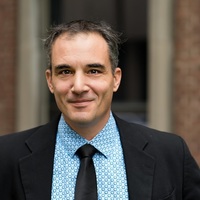Papers by Leonid K Antanovskii
Geometric Algebra is the most appropriate unifying mathematical language to describe diverse prob... more Geometric Algebra is the most appropriate unifying mathematical language to describe diverse problems in mathematics, physics, engineering and com-puter science. In combination with Projective Geometry it provides an effi-cient framework for computer vision and robotics, where image processing and recognition play the central rôle. This document addresses a gentle introduc-tion to Geometric Algebra followed by its implementation in MATLAB. The developed fully vectorized code is thoroughly tested. Several applications are presented in the form of unit tests, amongst which are some basic algorithms for the reconstruction of a three-dimensional structure from two-dimensional images.

Method for modeling injection of a fluid into a mold defining a three dimensional cavity, the met... more Method for modeling injection of a fluid into a mold defining a three dimensional cavity, the method comprising the steps of: (a) providing (20) a three dimensional solid computer model defining the cavity; (B) discretizing (30) A solution domain based on the solid model; (C) specifying (40) boundary conditions; clearing one or both of: (d) the variables (50) of the process of filling phase in at least a first portion of the solution domain to provide solutions respective filling therefore for at least the first part of the domain solutions; and (e) the variables (60) of the process of packing phase in at least some of the first part of the solution domain based in part on respective states of the process variables at termination of filling, to provide solutions respective filling phase therefore for at least some of the first part of the solution domain; and (f) determining (80) if at least one of the solutions of the filling phase and solutions stage respective filling is acceptab...
In this report the Computer Vision System toolbox of MATLAB R © and the Visual Structure from Mot... more In this report the Computer Vision System toolbox of MATLAB R © and the Visual Structure from Motion software are evaluated on three datasets of airborne imagery, provided by Defence Research and Development Canada, and on a dataset of synthetic imagery generated by the VIRSuite software developed in the Defence Science and Technology Group. The user interface for a developed code for structure reconstruction, based on the feature detection algorithms of the MATLAB toolbox, is described. RELEASE LIMITATION Approved for public release
European Journal of Mechanics B-fluids, 1994
European Journal of Mechanics B-fluids, 1994
: Geometric Algebra is the most appropriate unifying mathematical language to describe diverse pr... more : Geometric Algebra is the most appropriate unifying mathematical language to describe diverse problems in mathematics, physics, engineering and computer science. In combination with Projective Geometry it provides an efficient framework for computer vision and robotics, where image processing and recognition play the central role. This document addresses a gentle introduction to Geometric Algebra followed by its implementation in MATLAB. The developed fully vectorized code is thoroughly tested. Several applications are presented in the form of unit tests, amongst which are some basic algorithms for the reconstruction of a three-dimensional structure from two-dimensional images.
Phase transitions occur in a variety of physical phenomena ranging from condensation of gases to ... more Phase transitions occur in a variety of physical phenomena ranging from condensation of gases to solidification of liquids. It is of paramount importance to provide an adequate modelling of these phenomena in a thermodynamically consistent way. This paper addresses an introduction into the mathematical modelling of phase transitions in fluids from the perspective of consistently employing a modified Legendre transform of entropy considered as a given function of internal energy and volume. An explicit conservative scheme for incompressible phase transition and an implicit non-conservative scheme based on the fictitious-capacity and lubrication-theory approximations are implemented in MATLAB R ©. Illustrative numerical simulations are conducted, and some results are verified against an exact benchmark solution.
European Journal of Mechanics B Fluids, 1992
Pmtf Zhurnal Prikladnoi Mekhaniki I Tekhnicheskoi Fiziki, Apr 1, 1990
Pmtf Zhurnal Prikladnoi Mekhaniki I Tekhnicheskoi Fiziki, Dec 1, 1990
Journal of Loss Prevention in the Process Industries, Jul 1, 2013
Pmtf Zhurnal Prikladnoi Mekhaniki I Tekhnicheskoi Fiziki, Dec 1, 1991
This report describes an implementation of a Godunov-type solver for gas dynamics equations in MA... more This report describes an implementation of a Godunov-type solver for gas dynamics equations in MATLAB R. The main attention is paid to providing a generic code that can be easily adapted to particular problems in one, two or three dimensions. This is achieved by employing a cell connectivity matrix thus allowing one to use various structured and unstructured meshes without modification of the core solver. The code has been thoroughly tested for MATLAB Version 7.6 (Release 2008a).
Physical review. E, Statistical physics, plasmas, fluids, and related interdisciplinary topics, 1996

Microgravity Fluid Mechanics, 1992
The expansion of a liquid shell filled with solute gas under intensive heat exchange is an import... more The expansion of a liquid shell filled with solute gas under intensive heat exchange is an important step in the fabrication of spherical microspheres in a heated tower [1]. The present study is devoted to mathematical modelling of the above mentioned process. In Section 1, the authors present the general model considered to be applicable to describing all stages of the spherically symmetric expansion of a liquid shell under the above-mentioned conditions. However, the performed calculations show its insufficient efficiency. This can be explained by a very strong time change of thermal conditions and, consequently, fluid characteristics in producing microspheres in a heated tower. For example, for glass microspheres (on which production description the authors of the present paper oriented their studies), the temperature drops reach 2000θ K and fluid viscosity ranges from 10−1 to 1020 cm2/s while the process duration is 1 s. An abrupt change of parameters leads to the necessity of using a small time step, which increases the computation time. In Section 2, the authors propose various approximate models for different stages of the shell expansion. These are compared in numerical experiments. In Section 3, the phenomenological model, derived under the thin layer approximation without the assumption of spherical symmetry, is briefly described. It — could be applied to the investigation of the final stage of microsphere formation, its stability and refinement.









Uploads
Papers by Leonid K Antanovskii